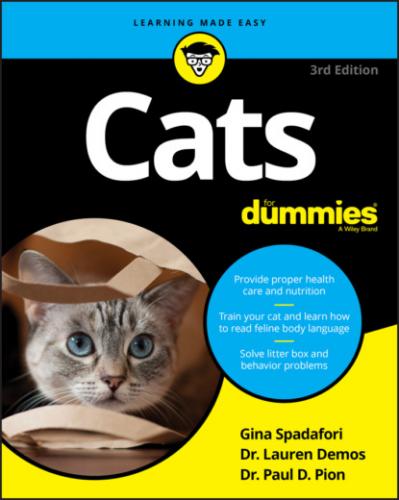© John Wiley & Sons, Inc.
FIGURE 2-2: You couldn’t get these cats to sit still for a photograph! Active breeds include the Abyssinian, Burmese, Cornish Rex, and Siamese.
A cat doesn’t need to be Siamese — or related somehow to the Siamese — to be above-average in terms of being on the go. Not as talkative generally, but just as busy, is the Abyssinian, with markings that suggest a mountain lion and a reputation for being one of the most intelligent and trainable of all breeds. Other breeds with energy to burn are the Bombay, the kinky-coated Cornish and Devon Rexes, the Egyptian Mau, the Somali (a longhaired Abyssinian), and the hairless Sphynx.
DO YOU WANT A CHATTY CAT?
One trait that is highly predictable by breed is noisiness. Some breeds are so quiet you hardly know they’re around, and others tell you every thought that crosses their minds, every minute they’re awake, with all manner of meows.
Siamese are probably best known for being chatty, but other breeds keep up their end of the conversation, too. The Balinese, a longhaired version of the Siamese, is, not surprisingly, very vocal, as are the Oriental Shorthair and Colorpoint Shorthair, also versions of the Siamese, and the Tonkinese, another breed developed from the Siamese. Other feline conversationalists include the Bombay, the Burmese, the Rexes, and the Ocicat.
The quietest cat breeds are generally those with heavier builds and more mellow dispositions: the Persian, the British Shorthair, and the Maine Coon.
A touch of the wild
One of the many things we humans find appealing about cats is that, even in the most tame and loving of our household companions, a touch of the tiger remains. Indeed, the tiger’s stripes remain on many of our pets, reminding us always of the connection — a reminder strengthened whenever you watch a cat walk, run, or leap. The grace and power are the same for big cats and for small.
Our cats may have chosen domestication, but on their own terms. And always, always, with a little bit of wildness held in reserve.
That we love this essential wildness is apparent in our long-standing interest in cat breeds that retain the look of the wild about them — not with the “ordinary” tiger stripes of the tabby but with spotted coat patterns evocative of another great wild cat, the leopard.
Most cats with a spotted “wild look” haven’t any wild blood in them at all — they’re the results of breeders trying to develop coat patterns that resemble the domestic cat’s wild cousins (see Figure 2-3). You can put into this category the Ocicat, derived from breedings of the Siamese and Abyssinian and named for the Ocelot, which it resembles. The Egyptian Mau (Mau means cat in Egyptian) is another spotted wonder, a lovely cat bred to resemble the cats seen in ancient Egyptian artwork.
© John Wiley & Sons, Inc.
FIGURE 2-3: The Bengal, Egyptian Mau, and Ocicat evoke the beauty of the Leopard with their spotted coats.
A cat of a different variety altogether is the Bengal, a cat developed through breedings of domestic cats with wild Asian Leopard Cats. Fanciers say the wild temperament has been removed by generations of breeding only the most sociable and friendly Bengals, although the look of the wild cat it came from remains. The Toyger is a litter easier to live with for many people without the cross to wild cats. They’re smaller than Bengals but maintain the wild look without the wild breeding.
The temperament of these “wilder” breeds generally lies somewhere in the middle between the go-gos and the more easygoing breeds, which we discuss next. They’re not placid layabouts, but neither are they as active as some breeds. For those who love the look of a leopard in a manageable, loving package, these cats are perfect.
Longhaired beauties
The Persian is the other cat besides the Siamese that nearly anyone, cat lover or not, can recognize. The incredible coat of this breed has enchanted cat lovers for centuries. Whenever companies look for a breed that says “glamour” to use in their advertising, that they often settle on a Persian is no accident. This cat is a glamour-puss, no doubt about it (see Figure 2-4).
© John Wiley & Sons, Inc.
FIGURE 2-4: The Birman, Himalyan and Persian are all cherished for their luxurious, long coats.
Perhaps no cat besides the Persian comes in as many varieties, each cat resplendent in that incredible coat: tabbies of every color, torties, calicos, every imaginable solid color, and tipped coats, too. The markings of the Siamese can be found in the Himalayan, which in cat shows is considered a pointed Persian.
If you’re looking for a more natural longhair, you have plenty of options. The Turkish Angora and Turkish Van are two ancient longhaired cats. The Norwegian Forest, Maine Coon, and Siberian cats are longhairs that still have the rough-and-tumble look of farm cats about them. And don’t forget the Birman, the sacred cat of Burma, a breed that looks somewhat like a Himalayan, with color darker at the points, except for the perfectly white-mitted paws.
The Ragdoll is another pointed longhair with white mittens of more-modern origins — it was “invented” in the 1960s — and is another choice for those seeking a longhaired cat, especially one designed to have an extremely laid-back temperament. Another lovely longhair with a relatively short history is the Chantilly/Tiffany, a cat with silky hair, commonly chocolate colored.
